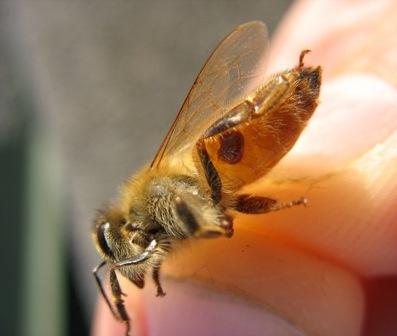The Varroa Destructor Mite has caused a mighty big problem for beekeepers.
The parasitic mite, which the Ontario Ministry of Agriculture, Food, and Rural Affairs (OMAFRA) calls the most serious threat to honeybees, has had a devastating effect on reducing the bee population in recent months, and has almost completely destroyed some colonies, while others have been not as seriously affected.
According to beekeeper John McCaig of Dalkeith, the mite uses bees as a host. Through a process of latching onto queen bees and reproducing in the broods within hives, the parasitic mites spread pathogens and viruses that weaken, and eventually kill bees. Damage from the mite usually occurs during winter. McCaig said one way to minimize the potential damage from varroa mites is to detect it and breed it out of the queens.
“We’ve managed it since I started,” McCaig said.
Normally, varroa damage is more localized, but during the winter of 2021-2022, it was significant across Canada.
“It’s just strange that it happened coast to coast,” said McCaig.
Greater than average losses were seen in McCaig’s colony over the past winter. He estimated they were 15 per cent more than usual. McCaig knows of other apiarists who lost 10,000 to 15,000 bees.
“Most people lost,” he said.
There are treatments beekeepers may use to stop the spread of the Varroa Destructor but McCaig still believes breeding out the potential for problems is the best strategy to take.
Beekeeper Russell Gibbs of Gibbs Honey in Vankleek Hill said keeping watch for potential varroa mite damage has become a regular hazard of his trade.
“It’s a problem that we face every year,” Gibbs said.
He estimated 50 per cent of his colony was affected by the mite over the winter of 2021-2022. Gibbs remarked that normally, 50 per cent would be bad news, but other beekeepers lost 80 to 90 per cent of their colonies.
He said there is no explanation for the more severe varroa-related damage experienced this year. However, Gibbs did say that less foraging space, clear cutting, and the cumulative effects of pesticides also have negative effects on the bee population.
Gibbs said he is focusing on adding new queens to help revive the number of bees in his colony.
“We can rebound our number within a year, or a year and a half,” he said.
As for how the decimating effects of the Varroa Destructor mite may affect the price of honey, Gibbs said it will depend on how the rest of this year goes. He said other factors such as time, supplies, and production costs also influence prices.
“Ultimately, the price of our honey reflects what we put into it,” said Gibbs.

Brood infested with Varroa Destructor mites. Photo: OMAFRA


